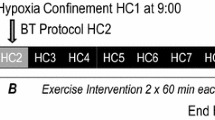Abstract
The effect of two different light intensities (dim, 50 lux andbright, 5,000 lux) on handgrip exercise in a climatic chamber (26°C, 60% relative humidity) were studied in eight female subjects, aged 20-24 years. The subjects were in either the dim or bright light from 1000 hours to 1800 hours. They were then in 50 lux from 1800 hours to 2200 hours in complete darkness from 2200 hours to 0600 hours (sleep), and again in 50 lux from 0600 hours to 0800 hours. They were instructed to perform handgrip exercise with a hand ergometer until the occurrence of exhaustion from 0600 hours. The influence ofdim andbright intensities during the previous daytime on the number of contractions was compared. The main findings were firstly that the mean number of contractions was 766.63 SEM 43.28 indim and 864.5 SEM 54.76 inbright intensities (P < 0.01), and secondly that rectal temperatures were slightly but significantly lower in thebright than in thedim intensities. The reason for the reduced number of contractions indim was discussed in terms of the establishment of a higher set-point in the core temperature indim.
Similar content being viewed by others
References
Cagnacci A, Elliott JA, Yen SSC (1992) Melatonin: a major regulator of the circadian rhythm of core temperature in humans. J Clin Endocrinol Metab 75:447–452
Cagnacci A, Soldani R, Romagnolo C, Yen SSC (1994) Melatonininduced decrease of body temperature in women: a threshold event. Neuroendocrinolgy 60:549–552
Clarke RSJ, Hellon RF (1959) Hyperaemia following sustained and rhythmic exercise in the human forearm at various temperatures. J Physiol 145:447–458
Edwards RHT, Harris RC, Hultman E, Kaijser L, Koh D, Nordesjö LO (1972) Effect of temperature on muscle energy metabolism and endurance during successive isometric contractions sustained to fatigue of the quadriceps muscle in man. J Physiol (Lond) 220:335–352
Febbraio MA, Snow RJ, Stathis CG, Hargreaves M, Carey MF (1994) Effect of heat stress on muscle energy metabolism during exercise. J Appl Physiol 77:2827–2831
Hirata K, Nagasaka T, Nonomura T, Hirai A, Hirashita M (1987) Effect of facial fanning on local exercise performance and thermoregulatory responses during hyperthermia. Eur J Appl Physiol 56:43–48
Irondelle M, Freund H (1977) Carbohydrate and fat metabolism of unacclimatized men during and after submaximal exercise in cool and hot environments. Eur J Appl Physiol 37:27–38
Ishihara Y, Tsuboi Y, Fujita S (1993) Physiological and biochemical studies on the effect of light on human body (in Japanese). Jpn J Hyg 48:332
Kim HE, Tokura H (1995) Influence of different light intensities during the daytime on evening dressing behavior in the cold. Physiol Behav 58:779–783
Kozlowski S, Brzeziñska Z, Kruk B, Kaciuba-Uscilko H, Greenleaf JE, Nazar K (1985) Exercise hyperthermia as a factor limiting physical performance temperature effect on muscle metabolism. J Appl Physiol 59:766–773
Kruk B, Kaciuba-Uscilko H, Nazar K, Greenleaf JE, Kozlowski S (1985) Hypothalamic, rectal and muscle temperatures in exercising dogs: effect of cooling. J Appl Physiol 58:1444–1448
Olschewski H, Brück K (1988) Thermoregulatory, cardiovascular, and muscular factors related to exercise after precooling. J Appl Physiol 64:803–811
Schmidt V, Brück K (1981) Effect of precooling maneuver on body temperature and exercise performance. J Appl Physiol 50:772–778
Tokura H, Yutani M, Morita T, Murakami M (1994) Effect of bright and dim light intensities during daytime upon circadian rhythm of core temperature in man. In: Milton AS (ed) Temperature regulation. Birkhäuser, Basel, pp 285–289
Author information
Authors and Affiliations
Rights and permissions
About this article
Cite this article
Zhang, P., Tokura, H. Influence of two different light intensities during daytime on endurance performance of handgrip exercise. Europ. J. Appl. Physiol. 74, 318–321 (1996). https://doi.org/10.1007/BF02226927
Accepted:
Issue Date:
DOI: https://doi.org/10.1007/BF02226927




